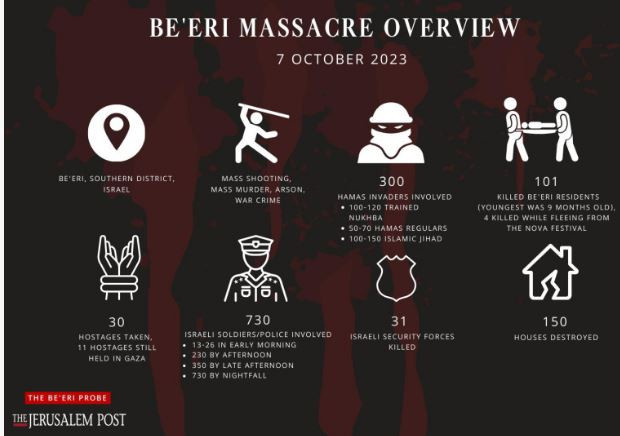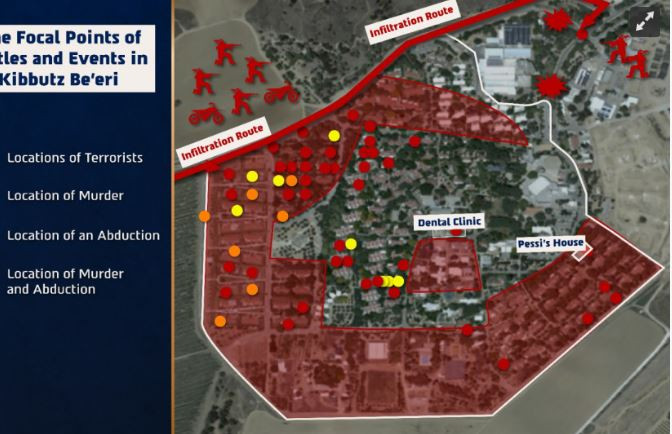During the invasion of Kibbutz Beeri 101 residents were killed, 30 were taken hostage, of which 11 are still being held by Hamas in Gaza
Shocking details emerging from the Israel Defense Forces’ first investigation into Israel’s failure to prevent Hamas’s October 7 invasion of Kibbutz Be’eri, which runs parallel to central Gaza, are shocking.
During the invasion, 101 residents were killed, 30 hostages were taken, of which 11 are still being held by Hamas in Gaza, 150 houses were destroyed and several disasters occurred.
According to research published by the Jerusalem Post, from the time Hamas breached the security gate of Kibbutz Beeri at 6:55 a.m. until 2:30 p.m., the number of Hamas fighters was between 80 to 220, far outnumbering the Israeli soldiers who ranged from 13 to 26 throughout the period.
Most of the approximately 1,000 residents of Kibbutz Beeri were in grave danger, but tried to stay out during the invasion in safe rooms in their homes until 6:00 p.m. about when the first major evacuations began.
Between 6:55 A.M. and 2:30 p.m., many things went wrong for the IDF and Shin Bet as they failed on the intelligence front but also because of the lack of forces to prevent the Hamas invaders from reaching Kibbutz Be’eri in the first place.
By around 7:30 AM, Hamas had already attacked and destroyed the IDF headquarters for Gaza in Reim, which would be the main point that would coordinate the reinforcements.
The Gaza Division Commander eventually fled and no one was left around to coordinate a broad reinforcement or defense operation.
About 20 Hamas forces had infiltrated the village from two different points in a short period of time.
The first hostages
By 8:00 AM, Hamas had taken the first two hostages to Gaza, with seven more captured by 9:00 AM. and another 12 until 10:00 am.
Around 9:45 am, the first reinforcements, the Shaldag special forces unit, engaged in hostilities with Hamas forces in an attempt to rescue residents.
However, by that time, Hamas had 80 fighters in the area and repulsed the forces of the Shaldag unit, many of whom retreated.
The inquiry called the retreat of the Shaldag forces a serious mistake, while praising the fighting spirit of the Shaldag forces during the rest of the 7-8 October period as well as throughout the Gaza war in general.
Around 10:45 a.m., Sayeret Matkal special forces were on their way to help in Beeri, but were ambushed at Junction 232, which had been taken over by other Hamas forces. This delayed them entering Beeri until 1:30 p.m.
By 12:00 noon, Hamas had taken 11 more hostages in Gaza, the last group it managed to kidnap. Several other forces that were nearby during the afternoon and evening failed to enter Beeri earlier, either because they expected more commanders to appear or because they felt that the role was limited to evacuating the residents.
The IDF investigation attributes passivity to these security forces while emphasizing that they had to risk their lives to protect civilians.
Important developments
By 1 p.m., two major developments had occurred, the survey said.
The IDF High Command had only begun to handle the situation at around 11:00 AM, but by 1:00 PM, it had instructed some zone commanders on the Gaza border to proceed with a recapture.
Also, by 1:00 p.m., the IDF had recaptured junction 232 which Hamas had been using throughout the morning to set up ambushes and block Israeli efforts to reinforce Gaza’s border towns.
By 2:30 p.m., with 230 Israeli soldiers to Hamas’s 219, the IDF finally had its first military advantage and began to impose and isolate the remaining Hamas forces.
Around 10:00 PM, Israeli forces reached 730 soldiers. The investigation notes the contribution of two tanks to driving Hamas out of Beeri, although they arrived late in the afternoon.
The role of aviation
Although the investigation does not name the air force, previous leaks have blamed air force fighter jets for not participating in the defense of the Gaza border.
Instead, IDF helicopters contributed, although it was difficult to fully respond, since they arrived only after Hamas was already engaged with residents.
The research concludes that even after the initial support in Beeri, not everyone realized the extent of the invasion or the threat. In fact, when they retreated from the kibbutz the first time, they thought they had successfully neutralized a small group of intruders, against whom they had fired warning shots.
It was only when they reached Nahal Oz and saw the large number of Hamas infiltrators crossing the border that they resorted to open-fire rules on anyone who appeared to be affiliated with Hamas.
Even after that point, it was not easy to respond for many hours, as the helicopter pilots were not always sure who was Israeli and who was a Hamas fighter.
IDF Chief of Staff Lt. Gen. Herchi Halevi said: “Although this is only the first and only investigation that does not represent the full picture of what happened that day, it clearly demonstrates the enormity of the failure and its multiple dimensions. devastation that befell the residents of the South who defended their families alone for many hours when the IDF was not there to protect them.”
Source :Skai
With a wealth of experience honed over 4+ years in journalism, I bring a seasoned voice to the world of news. Currently, I work as a freelance writer and editor, always seeking new opportunities to tell compelling stories in the field of world news.













